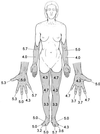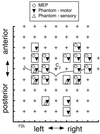Beyond re-membering: phantom sensations of congenitally absent limbs
- PMID: 10801982
- PMCID: PMC18576
- DOI: 10.1073/pnas.100510697
Beyond re-membering: phantom sensations of congenitally absent limbs
Abstract
Phantom limbs are traditionally conceptualized as the phenomenal persistence of a body part after deafferentation. Previous clinical observations of subjects with phantoms of congenitally absent limbs are not compatible with this view, but, in the absence of experimental work, the neural basis of such "aplasic phantoms" has remained enigmatic. In this paper, we report a series of behavioral, imaging, and neurophysiological experiments with a university-educated woman born without forearms and legs, who experiences vivid phantom sensations of all four limbs. Visuokinesthetic integration of tachistoscopically presented drawings of hands and feet indicated an intact somatic representation of these body parts. Functional magnetic resonance imaging of phantom hand movements showed no activation of primary sensorimotor areas, but of premotor and parietal cortex bilaterally. Movements of the existing upper arms produced activation expanding into the hand territories deprived of afferences and efferences. Transcranial magnetic stimulation of the sensorimotor cortex consistently elicited phantom sensations in the contralateral fingers and hand. In addition, premotor and parietal stimulation evoked similar phantom sensations, albeit in the absence of motor evoked potentials in the stump. These data indicate that body parts that have never been physically developed can be represented in sensory and motor cortical areas. Both genetic and epigenetic factors, such as the habitual observation of other people moving their limbs, may contribute to the conscious experience of aplasic phantoms.
Figures





Similar articles
-
Motor cortex representation of the upper-limb in individuals born without a hand.PLoS One. 2011 Apr 8;6(4):e18100. doi: 10.1371/journal.pone.0018100. PLoS One. 2011. PMID: 21494663 Free PMC article.
-
Phantom digit somatotopy: a functional magnetic resonance imaging study in forearm amputees.Eur J Neurosci. 2012 Jul;36(1):2098-106. doi: 10.1111/j.1460-9568.2012.08099.x. Epub 2012 Apr 26. Eur J Neurosci. 2012. PMID: 22537316
-
Phantom limb experiences in congenital limb-deficient adults.Cortex. 1994 Sep;30(3):479-85. doi: 10.1016/s0010-9452(13)80343-7. Cortex. 1994. PMID: 7805388
-
Phantom representations of congenitally absent limbs.Percept Mot Skills. 1990 Jun;70(3 Pt 2):1227-32. doi: 10.2466/pms.1990.70.3c.1227. Percept Mot Skills. 1990. PMID: 2204877 Review.
-
Transcranial magnetic stimulation in subjects with phantom pain and non-painful phantom sensations: A systematic review.Brain Res Bull. 2019 May;148:1-9. doi: 10.1016/j.brainresbull.2019.03.001. Epub 2019 Mar 9. Brain Res Bull. 2019. PMID: 30862485
Cited by
-
Does Body Memory Exist? A Review of Models, Approaches and Recent Findings Useful for Neurorehabilitation.Brain Sci. 2024 May 25;14(6):542. doi: 10.3390/brainsci14060542. Brain Sci. 2024. PMID: 38928542 Free PMC article. Review.
-
Hand movement observation by individuals born without hands: phantom limb experience constrains visual limb perception.Exp Brain Res. 2005 Jul;164(3):341-6. doi: 10.1007/s00221-005-2255-4. Epub 2005 Apr 8. Exp Brain Res. 2005. PMID: 15818499
-
Motor cortex representation of the upper-limb in individuals born without a hand.PLoS One. 2011 Apr 8;6(4):e18100. doi: 10.1371/journal.pone.0018100. PLoS One. 2011. PMID: 21494663 Free PMC article.
-
An Overview of the Bodily Awareness Representation and Interoception: Insights and Progress in the Field of Neurorehabilitation Research.Brain Sci. 2024 Apr 16;14(4):386. doi: 10.3390/brainsci14040386. Brain Sci. 2024. PMID: 38672035 Free PMC article. Review.
-
Neural correlates of evoked phantom limb sensations.Biol Psychol. 2017 May;126:89-97. doi: 10.1016/j.biopsycho.2017.04.009. Epub 2017 Apr 23. Biol Psychol. 2017. PMID: 28445695 Free PMC article.
References
Publication types
MeSH terms
LinkOut - more resources
Full Text Sources
Other Literature Sources
Medical

